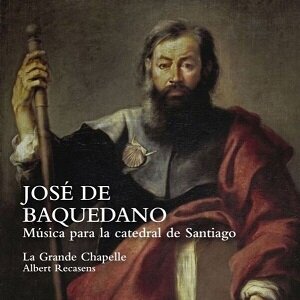
José de Baquedano (1642-1711)
Latin Music for the Cathedral of Santiago
La Grande Chapelle/Albert Recasens
rec. 2021, Ingreja do Menino Deus, Lisbon, Portugal
Lauda LAU022 [67]
I had not known this composer but I feel connection to his music: I have twice made the pilgrimage to Santiago de Compostela in Northern Spain, and it has left a life-long impression. The iconic cathedral is an astonishing Romanesque sculpture, especially the Porta da Gloria (which one now must pay to see whilst being scrutinised by security guards). Inside, the memorable sights are the Renaissance cloisters, the Baroque main altar and some of the side chapels, and the tower and the extraordinary west facade. From 1672, José Peña de Toro and Domingo Antonio Andrade were set the huge task of remodelling the cathedral in a contemporary style
It was then, in 1680, that Baquedano was appointed choir master at the cathedral; he left his happy position in Madrid for twice the salary. As one gazes towards the high altar and becomes aware of the space and the wonderful acoustic, polychoral motets seem to be the obvious choice of music for this wondrous building. This is the essence of Baquedana, as is his ability to set the chosen texts with expressivity and emotion. We are fortunate that his music has been rescued from obscurity. But the choir stalls in the central nave – which the composer knew and in which the music was first heard – have been removed. They are now on the upper floor of the nearby monastery. So, one cannot completely recapture the sound the composer envisaged.
Baquedano’s style was typically Iberian: it tended towards the conservative. Alongside Baroque elements, Renaissance polyphony is still the mainstay of his language. There is an occasional if pertinent use of homophony or, as the booklet writer calls it, vertical harmony. So, the music matches the architecture. Archbishop Antonio de Monroy was the brains behind the rebuilding of the cathedral and behind the promotion of the Arts there and then. It seems he was a difficult man, an austere monk and an extravagant prince. The cathedral’s Lady of the Pillar chapel contains his remains and tomb.
The ensemble La Grande Chapelle consist of nine voices and seven instrumentalists who play strings, harp and organ (the authorities in the 1680s and 1690s also seemed to have employed wind players on occasion). They present us with motets for the Assumption, the Purification, Passiontide and the Ascension. The motets are in contrasting moods suitable for the season. There also are two settings of the Lamentations; the booklet says that there are five others among over Boquedano’s one hundred surviving works. The style is again tightly polyphonic, and the motets favour the cori spezzati technique of the previous generations particularly in Italy and Germany – as in the closing motet Viri Galilaei.
The Miserere interestingly has verses for the full ten-part choir but a group of soloists take on more of the verses alternating with the plainchant. There are also verses of antiphony between the tutti and the solo voices.
The booklet is superbly and almost extravagantly presented with a variety of religious and architectural illustrations from manuscripts and of the baroque elements of the cathedral. We also have full texts and translations and two well translated, lengthy essays. The first, by Ofelia Rey Castelao is snappily entitled ‘Financing the Cathedral of Santiago de Compostela’s music chapel’ and gives us an historic background into the world that Baquedano was stepping into, the second, a very much longer essay by the group’s director Albert Recasens is more biographical, repeating some details but giving us more musical analysis. His commitment to this music is clear and he has a firm understanding of style and pacing.
These then are both moving and strong performances with some superb solo work and they are aided by the recording which is spacious and clear but sometimes the balance of the voices is unsettling with a strong emphasis on the lower part. Sadly however, it was not recorded at Compostella but in the baroque splendour of an early eighteenth-century church in Lisbon which I thrillingly recall viewing once during an organ recital.
Gary Higginson
Help us financially by purchasing from



Contents
Assumpta est Maria, motet [2:36]
Senex puerum, motet [3:17]
Interveniat pro nobis, motet [4:23]
Domine ne in furore, psalm (1674) [6:29]
O crux, ave spes, motet [3:50]
Incipit Lamentatio… Aleph. Quemodo sedet [16:53]
Iod. Manum suam, lamentatio III [9:28]
Miserere a 10, psalm [13:37]
Laudate Dominum a 12, pPsalm [4:10]
Viri Galilaei a 8, motet (1687) [2:33]


















